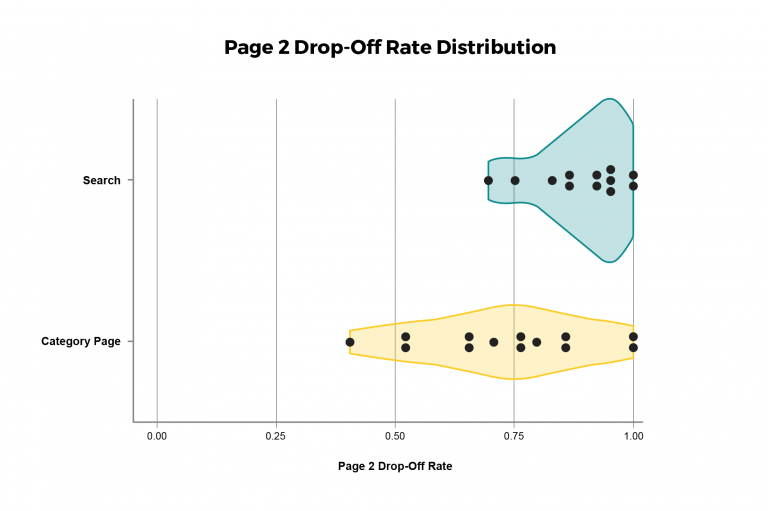
How Far Do Customers Browse on eCommerce Sites? Not as Far as You Think.

For pretty obvious reasons, we at Avatria are obsessed with the way eCommerce consumers shop. Understanding shopping behavior is crucial to both building world-class eCommerce products and providing our clients with the best advice possible. You can learn a lot simply by osmosis—by talking to eCommerce managers and developers day in and day out about the trends and issues they’re seeing—but when possible, we try to validate what we’re hearing with hard data. Anecdotes and impressions are great, but quantitative evidence makes it easier to justify decisions and settle disputes.
An expression has been floating around that supposedly describes a painful truth of eCommerce shopping habits; it goes something like this: You could bury a body on page two, and no one would ever find it. Ostensibly, this quip is describing a form of what academics have deemed “position bias,” the idea that search users have become so conditioned to finding something relevant almost immediately that they no longer even try to dig. It’s one of those ideas that feels right (when was the last time you clicked into the second page of search results for an answer?), but is much harder to find good data about. Fortunately, we have a lot of eCommerce data at hand, so we decided to try to dive into the question for ourselves.
Our Methodology
We decided to evaluate this theory formally. Our question: what percentage of users who navigate to a product list (either a category list or search result set) have ever navigated beyond the first page of results? To simplify things, we decided to analyze categories and search results separately. Users are less likely to have a specific product in mind when navigating to a category, we assumed, and thus may be more likely to browse further.
To begin, we created a set of user segments in Google Analytics. Using URL query parameters on the page path, we created four segments:
Category Page Users – Users who visited any category page
Category Page 2+ Users – Users who visited a category page that was page 2 or higher
Search Results Page Users – Users who visited any search results page
Search Results Page 2 + Users – Users who visited a search results page that was page 2 or higher
By pulling user counts for each segment, we could easily create a new metric to determine what percentage of users who visited a list page failed to view the second page of a list. We’re calling this metric “Page 2 Dropoff Rate,” calculated as:
1 - ([Context] Page 2+ Users / [Context] Page Users)
Our analysis included 13 client sites* over a 6 month date range, and incorporated the usage data of almost 6 million users. These sites are primarily consumer-oriented eCommerce sites featuring a range of traffic volumes, but we did include a handful of B2B sites as well.
A few notes on the implications of our approach:
A “Page 2+ user” is a user on a particular site who has ever visited the first page of a product list and then navigated to a page numbered higher than 1 for that same product list.
Product lists that did not have multiple pages were not identified nor excluded from our study.
*One site was unable to be included in search dropoff analysis.
Results
Although page 2+ dropoff rates varied by site, a clear pattern has emerged from the data. Burying the body on the second page may not be a great strategy for getting away with murder, but you’ll definitely have time to make a getaway.

Across all sites included in the study, an average of 73% of category page users never visited the second page of a category. Only one site featured a dropoff rate of less than 50%, while eight sites had dropoff rates higher than 70%. While there was a gap in this trend between B2B and B2C clients—B2B sites averaged a 90.91% dropoff rate whereas B2C sites saw one of 65.09%—users who dropped off after page 1 were the strong majority for both types of sites.
For search users, the trend was even more pronounced—an average of over 89% of users never visited the second page of results. The lowest dropoff rate recorded for search was 70%*, while 10 of 12 sites recorded a dropoff rate higher than 80%. This trend is also reflected when you split out B2B sites from B2C sites, where base figures were higher for both, and the divide was smaller—95.35% for B2B, 86.19% for B2C.
*Interestingly, the site with the lowest search dropoff rate was also the site with the lowest category dropoff rate. We can’t see anything in the nature of their product listing pages that might be causing this trend, which suggests that there is something unique about the nature of their product catalog or customer base leading to this phenomenom.
Takeaways
The focus and effort of internet users can’t be taken for granted, which may seem obvious to anyone who has watched the frictionless discovery experiences of Google and Amazon take over the world over the last two decades. With more and more competitors vying for consumer attention, and continually improving technology creating ever-smoother search and shop experiences, the goal of every eCommerce site should be to optimize the engagement they’re given. Putting the best possible products at the top of your product lists is essential; failing to do so leads to lower conversion rates, smaller order values, and increased risk that loyal customers shop elsewhere.
Beyond page 2+ exploration, there is demonstrated evidence that position bias generally causes the probability of users engaging with an item in a product list to drop off quickly the further down the item is placed. This poses the chicken-vs-egg question—can you be sure that the first few items on your product categories actually deserve to be there, or do they just get high clickthrough rates because users are biased towards the top positions anyway?
The good news is that there is some low-hanging fruit that can help you improve the relevance of the products you’re showing customers in categories and search results. Consider the following:
Improved Sort Strategies – If you have product lists that sort by Price, Arrival Date, or Alphabetical by default, consider switching to a more sophisticated sort order such as Best Sellers or Relevance, which many eCommerce platforms and search engines offer out of the box.
Infinite Scroll – Have you considered implementing infinite scroll or lazy load functionality on your product lists? While these features won’t solve the fundamental problem, the lack of hard page limits may encourage users to view more products than they would otherwise, which can increase the likelihood that they discover a product they’re interested in.
Avatria Convert – We built our own solution, Avatria Convert, to solve this very problem. Convert uses shopping data and machine learning to ensure that the most relevant items are at the top of every product list. Our algorithms are specifically tuned to combat position bias, boosting items that customers genuinely want instead of applying simplistic rules. Convert can even incorporate personalized data to ensure that each user sees the unique set of products that they’re most likely to purchase. Convert is designed to be fast and easy to implement, and works with any eCommerce platform or search engine you may use.
Search Tuning – If you’re not actively managing your site search tool, chances are that it’s not working as well as it could. Avatria offers professional search enhancement services to help you identify inefficiencies in your current solution and develop strategies for improvement.